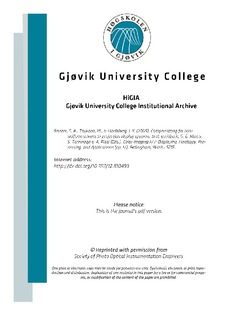| dc.contributor.author | Renani, Siavash Asgari | |
| dc.contributor.author | Tsukada, Masato | |
| dc.contributor.author | Hardeberg, Jon Yngve | |
| dc.date.accessioned | 2011-05-04T08:59:32Z | |
| dc.date.available | 2011-05-04T08:59:32Z | |
| dc.date.issued | 2009 | |
| dc.identifier.citation | Renani, S. A., Tsukada, M., & Hardeberg, J. Y. (2009). Compensating for non-uniform screens in projection display systems. In R. Eschbach, G. G. Marcu, S. Tominaga & A. Rizzi (Eds.), Color Imaging XIV: Displaying, Hardcopy, Processing, and Applications (pp. 12). Bellingham, Wash.: SPIE. | en_US |
| dc.identifier.isbn | 9780819474919 | |
| dc.identifier.issn | 0277-786X | |
| dc.identifier.uri | http://hdl.handle.net/11250/142500 | |
| dc.description | This is the copy of journal's version originally published in Proc. SPIE 7241. Reprinted with permission of SPIE: http://spie.org/x10.xml?WT.svl=tn7 | en_US |
| dc.description.abstract | In this paper the performance of screen compensation based on previous work by Nayar et al. and Ashdown et al. and five different camera characterization methods are evaluated. Traditionally, colorimetric characterization of cameras consists of two steps; a linearization and a polynomial regression. In this research, two different methods of linearization as well as the use of polynomial regression up to fourth order have been investigated, based both on the standard deviation and the average of color differences. The experiment consists of applying the different methods 100 times on training sets of 11 different sizes and to measure the color differences. Both CIELAB and CIEXYZ are used for regression space. The use of no linearization and CIELAB is also investigated. The conclusion is that the methods that use linearization as part of the model are more dependent on the size of the training set, while the method that directly convert to CIELAB seems to be more dependent on the order of polynomial used for regression. We also noted that linearization methods resulting in low error in the CIEXYZ color space do not necessarily lead to good results in the CIELAB space. CIELAB space gave overall better result than CIEXYZ; more stabile and better results. Finally, the camera characterization with the best result was combined into a complete screen compensation algorithm. Using CIELAB as a regression space the compensation achieved results between 50 an 70 percents more similar to the same color projected on a white screen than using CIEXYZ (as measured by a spectrophotometer, comparing absolute color difference in CIELAB) in our experimental setup. | en_US |
| dc.language.iso | eng | en_US |
| dc.publisher | Society of Photo Optical Instrumentation Engineers (SPIE) | en_US |
| dc.relation.ispartofseries | Proceedings of SPIE;7241 | |
| dc.title | Compensating for non-uniform screens in projection display systems | en_US |
| dc.type | Journal article | en_US |
| dc.type | Peer reviewed | en_US |
| dc.subject.nsi | VDP::Mathematics and natural science: 400::Information and communication science: 420::Simulation, visualization, signal processing, image processing: 429 | en_US |
| dc.source.pagenumber | 12 s. | en_US |
| dc.identifier.doi | http://dx.doi.org/10.1117/12.810493 | |
